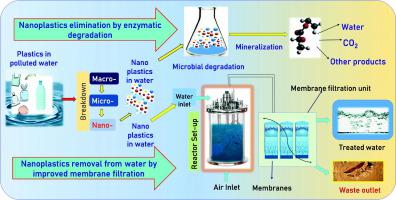Science of the Total Environment ( IF 8.2 ) Pub Date : 2022-07-08 , DOI: 10.1016/j.scitotenv.2022.157168 M Keerthana Devi 1 , N Karmegam 2 , S Manikandan 1 , R Subbaiya 3 , Hocheol Song 4 , Eilhann E Kwon 5 , Binoy Sarkar 6 , Nanthi Bolan 7 , Woong Kim 8 , Jörg Rinklebe 9 , M Govarthanan 10

|
Nanoplastics are drawing a significant attention as a result of their propensity to spread across the environment and pose a threat to all organisms. The presence of nanoplastics in water is given attention nowadays as the transit of nanoplastics occurs through the aquatic ecosphere besides terrestrial mobility. The principal removal procedures for macro-and micro-plastic particles are effective, but nanoparticles escape from the treatment, increasing in the water and significantly influencing the society. This critical review is aimed to bestow the removal technologies of nanoplastics from aquatic ecosystems, with a focus on the treatment of freshwater, drinking water, and wastewater, as well as the importance of transit and its impact on health concerns. Still, there exists a gap in providing a collective knowledge on the methods available for nanoplastics removal. Hence, this review offered various nanoplastic removal technologies (microorganism-based degradation, membrane separation with a reactor, and photocatalysis) that could be the practical/effective measures along with the traditional procedures (filtration, coagulation, centrifugation, flocculation, and gravity settling). From the analyses of different treatment systems, the effectiveness of nanoplastics removal depends on various factors, source, size, and type of nanoplastics apart from the treatment method adopted. Combined removal methods, filtration with coagulation offer great scope for the removal of nanoplastics from drinking water with >99 % efficiency. The collected data could serve as base-line information for future research and development in water nanoplastics cleanup.
中文翻译:

在水处理过程中去除纳米塑料:综述
纳米塑料因其易于在环境中传播并对所有生物体构成威胁的倾向而引起了广泛关注。如今,纳米塑料在水中的存在引起了人们的关注,因为除了陆地流动之外,纳米塑料还通过水生生态圈进行运输。宏观和微观塑料颗粒的主要去除程序是有效的,但纳米颗粒会从处理中逸出,在水中增加并显着影响社会。这篇批判性评论旨在介绍从水生生态系统中去除纳米塑料的技术,重点关注淡水、饮用水和废水的处理,以及运输的重要性及其对健康问题的影响。仍然,在提供关于可用于去除纳米塑料的方法的集体知识方面存在差距。因此,本综述提供了各种纳米塑料去除技术(基于微生物的降解、反应器膜分离和光催化),这些技术可以与传统程序(过滤、混凝、离心、絮凝和重力沉降)一起成为实用/有效的措施. 从不同处理系统的分析来看,纳米塑料的去除效果除所采用的处理方法外,还取决于纳米塑料的来源、尺寸和类型等多种因素。联合去除方法、混凝过滤为从饮用水中去除纳米塑料提供了广阔的空间,效率 > 99%。


















































 京公网安备 11010802027423号
京公网安备 11010802027423号